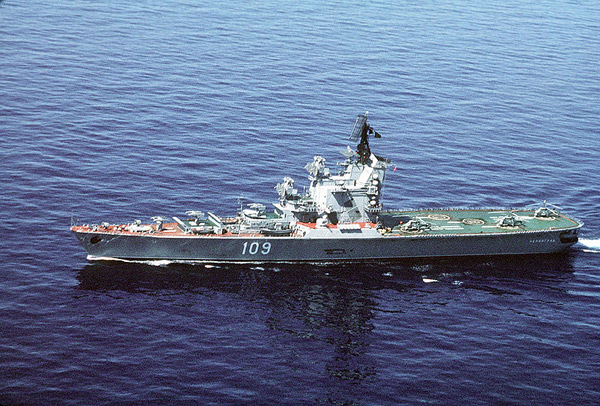Moskva-class
Summary
| Origin country | 🇨🇳 Ex-USSR |
| Category | Cruiser |
| Subtype | Helicopter cruiser |
| Manufacturer | Nikolayev Shipyard 444 |
| Year commissioned | 1967 |
Description
The Moskva class, known by the Soviet designation Project 1123 Kondor and S-703 Project 1123M Kiev, embodies the Soviet Union's initial foray into operational aircraft carriers, specifically helicopter cruisers according to Soviet classification. Developed for the Soviet Navy, construction occurred at the Nikolayev South Shipyard with the flagship vessel Moskva launched in 1965 and commissioned in 1967. It was joined by its sister ship Leningrad, which entered service in 1968. The production ceased after these two units, reportedly due to their inadequate performance in rough seas.
These ships, devoid of fixed-wing aircraft, were exclusively outfitted with helicopter air wings designed for anti-submarine warfare (ASW). Their arsenal and sensor systems were finely tuned to counter the nuclear submarine threat, protecting Soviet ballistic missile submarine zones from Western attack submarines. Positioned as the central component of an ASW task force, their primary mission was to detect and neutralize NATO Polaris submarines.
Conceived by Admiral Sergey Gorshkov in 1959 to host up to ten helicopters on an 8,000-ton vessel, the design advanced into a larger format allowing for a contingent of up to 14 helicopters. The Moskva class was equipped with a multitude of weaponry, including a twin SUW-N-1 launcher for torpedo or nuclear payload delivery, ASW mortars, torpedo tubes, dual SA-N-3 SAM launchers with a stockpile of 48 missiles, and two twin 57 mm guns for ship defense.
Propulsion for the Moskva class came from high pressure steam plants mirroring those used in Kynda-class cruisers. The design preference for steam over unproven gas turbines was ultimately a detriment; Moskva's machinery suffered a fire leading to a rebuild in 1973, and the ships faltered with a practical speed of 30 knots and a sustainable speed of 24 knots. Additionally, their sea-keeping performance was criticized.
Both vessels were active within the Black Sea Fleet, with Leningrad decommissioned in 1991 and Moskva in 1996. They were scrapped shortly after their service ended, in 1995 and 1997, respectively. Plans for a third ship, named Kiev, were discarded in 1969. The Kiev class succeeded the Moskva class, presenting a leap in size and capability for Soviet naval aviation endeavors.
Technical specifications
| Moskva | |
|---|---|
| Displacement | 17500 tons |
| Range | 16000 km at 14 knots |
| Endurance | 15 days |
| Crew | 850 members |
| Width | 34.0 m (111.5 ft) |
| Length | 189.0 m (620.1 ft) |
| Air Park | 18 Kamov Ka-25 Hormone ASW helicopters |
| Propulsion | 2 gas turbines with a total power of 100,000 hp - 4 propellers |
| Armament | 2 double launchers for SA-N-3 Goblet + 1 SUW-N-1 launcher for FRAS-1 ASM + 2 RBU-6000 ASM + 10 TLT 533 mm + 2 57 mm twin guns |
| Maximum speed | 29 knots |
Photo of Moskva class
